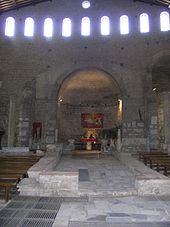Domitilla catacombs

The Domitilla Catacombs in Rome form the largest system of catacombs of the city's around sixty ancient catacombs . They contain graves from the first to the fourth century , with ancient and Christian iconography , set on four floors up to five meters high .
Location and naming
This largest underground cemetery in Rome is located southwest of the lower section of Via Ardeatina and south of Via delle sette chiese. The name is reminiscent of Flavia Domitilla from the imperial family of the Flavians , who initially made the land available as a burial place for her non-Christian freedmen in the 1st century. She is said to have been banished after converting to the Christian faith and to have died in exile as a martyr at the end of the 1st century or the beginning of the 2nd century. Towards the end of the 2nd century, a Christian catacomb emerged from this burial site , which was continuously expanded and expanded until the 4th century. At the beginning of the 4th century, the martyrs Nereus and Achilles were also buried here.
Early Christian painting
In the various burial chambers and on the walls of the corridors, numerous frescoes have been preserved that offer a good cross-section of the development history of Christian painting: symbols of life and resurrection from the early days , the scene of Daniel in the lions' den , one of the earliest representations of the Good Shepherd , an enthroned Madonna , the wise men from the Orient , who appear here in groups of four, as well as Christ and the apostles . Occasionally there are also mundane images, such as market scenes. All representations are painted “al fresco” on the still damp subsurface made of lime and marble dust after the porous tuff has been coated with it.
Jesus with Peter and Paul, above the Christ monogram
Apostle with Z = Zeta (ζῆτα) on the upper garment ( gammadion )
Stone tablet with inscription, alpha and omega and Christ monogram
Catacomb Basilica
About the Domitilla catacombs around 390 under Pope Siricius (384–399) the basilica Santi Nereo e Achilleo was built in such a way that half of the church was relocated below the surface of the earth, to the altar directly above the graves of the around 295 as Martyrs erecting deceased imperial soldiers Nereus and Achilles. This design is known as the catacomb basilica or basilica ad corpus . The martyrs' graves were originally located in a burial chamber ( cubiculum ), which had already been highlighted by Pope Damasus I (366–384) with a plaque; It is believed that the column with a depiction of the beheading of Achilles, which is now in the basilica in front of the chancel, was also part of it. This column shows how Achilles wants to flee to avoid being beheaded; In the background a cross with the victory wreath intended for the martyr becomes visible. The catacomb basilica was a three-aisled building (31 m long, between 17 and 12 m wide) with an apse in the west above the memoria and other martyrs' graves; a steep staircase led down to the narthex , from where one could enter the nave . The naves were separated from each other by arcades with pillars .
This coemeterial basilica , which fell into disrepair in the 9th century , was excavated in 1874 and rebuilt. It must not be confused with the church of the same name, Santi Nereo e Achilleo , near the Caracalla Baths , to which the relics of the church patrons and other saints were transferred in the 6th century.
Catacomb Pact
On November 16, 1965, a few weeks before the end of the Second Vatican Council , the Catacomb Pact was signed in the Catacomb Basilica , which 40 bishops from all over the world signed as the first signatories. The pact took up the motto of John XXIII. from a “Church of the Poor”. To date, more than 500 bishops around the world have signed up to the pact and committed themselves to a simple lifestyle and service to the poor, as well as renouncing pomp and titles.
Web links
- Website of the Domitilla Katabomben (various languages, including German)
- The Domitilla Catacomb in Rome. Archeology, architecture and art history of a late antique necropolis Website: Institute for Cultural History of Antiquity, Austrian Academy of Sciences
literature
- Anton Henze : Art Guide Rome . Reclam, Stuttgart 1994, p. 114
- Fabrizio Mancinelli: Guide to the Catacombs in Rome . Scala Florenz 2007, p. 46ff.
- Hans Georg Wehrens: Rome - The Christian sacred buildings from the 4th to the 9th century - A Vademecum . Herder, Freiburg 2nd edition 2017, pp. 164f.
Individual evidence
- ↑ Fabrizio Mancinelli: Guide to the Catacombs in Rome, Florence 2007, p. 46ff.
- ^ Anton Henze: Kunstführer Rom , Stuttgart 1994, p. 114
- ↑ Hans Georg Wehrens: Rome - The Christian Sacred Buildings from the 4th to the 9th Century - Ein Vademecum, Freiburg 2nd edition, 2017, p. 164f. with floor plan
- ↑ Sebastian Pittl: The catacomb pact - the forgotten legacy of Vatican II . Catholic Academic Association of the Archdiocese of Vienna . Retrieved October 21, 2012.
- ↑ Fifty Years of the Council (PDF; 142 kB) Archdiocese of Munich and Freising . Archived from the original on July 28, 2013. Retrieved October 21, 2012.
Coordinates: 41 ° 51 ′ 32.1 ″ N , 12 ° 30 ′ 19.9 ″ E










